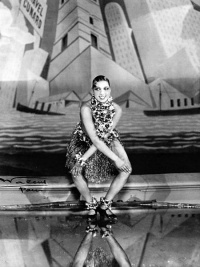Interwar period
From The Art and Popular Culture Encyclopedia

(Photo by Walery)
|
Related e |
|
Featured: |
The interwar period (also interbellum) is understood within Western culture to be the period between the end of the First World War and the beginning of the Second World War in Europe, specifically 11 November 1918 to 1 September 1939. It was marked by turmoil in much of the world, as Europe struggled to recover from the devastation of the First World War. In North America the first half of the interwar period is often seen as one of considerable prosperity (the roaring twenties), but this changed dramatically with the onset of the Great Depression in 1929.
Art
Expressionism and Symbolism are broad rubrics that describes several important and related movements in 20th century painting that dominated much of the avant-garde art being made in Western, Eastern and Northern Europe. Expressionism was painted largely between World War I and World War II, mostly in France, Germany, Norway, Russia, Belgium, and Austria. Expressionist artists are related to both Surrealism and Symbolism and are each uniquely and somewhat eccentrically personal. Fauvism, Die Brücke, and Der Blaue Reiter are three of the best known groups of Expressionist and Symbolist painters. Artists as interesting and diverse as Marc Chagall, whose painting I and the Village, (above) tells an autobiographical story that examines the relationship between the artist and his origins, with a lexicon of artistic Symbolism. Gustav Klimt, Egon Schiele, Edvard Munch, Emil Nolde, Chaim Soutine, James Ensor, Oskar Kokoschka, Ernst Ludwig Kirchner, Max Beckmann, Franz Marc, Käthe Schmidt Kollwitz, Georges Rouault, Amedeo Modigliani and some of the Americans abroad like Marsden Hartley, and Stuart Davis, were considered influential expressionist painters. Although Alberto Giacometti is primarily thought of as an intense Surrealist sculptor, he made intense expressionist paintings as well. In the USA during the period between World War I and World War II painters tended to go to Europe for recognition. Modernist artists like Marsden Hartley, Patrick Henry Bruce, Gerald Murphy and Stuart Davis, created reputations abroad. While Patrick Henry Bruce, and Marsden Hartley experimented with expressionism. During the 1920s photographer Alfred Stieglitz exhibited Georgia O'Keeffe, Arthur Dove, Alfred Henry Maurer, Charles Demuth, John Marin and other artists including European Masters Henri Matisse, Auguste Rodin, Henri Rousseau, Paul Cézanne, and Pablo Picasso, at his New York City gallery the 291. In Europe masters like Henri Matisse and Pierre Bonnard continued developing their narrative styles independent of any movement.
See also
- 1920s
- 1930s
- Aftermath of World War I
- European Civil War
- League of Nations
- Causes of World War II
- Events preceding World War II in Europe
- Golden Age of Aviation
- Interwar period events
- List of treaties
See also

